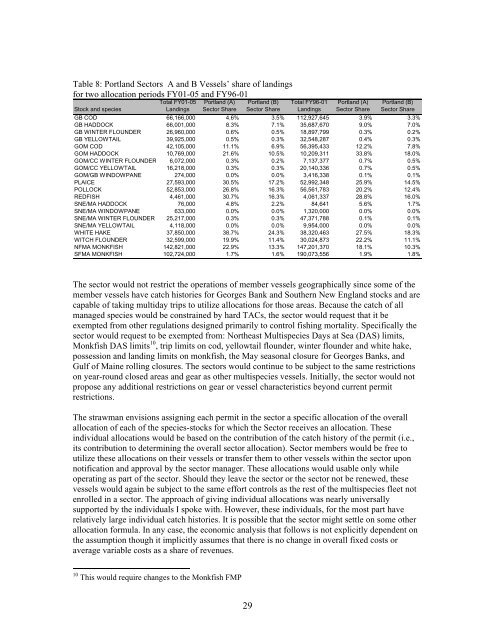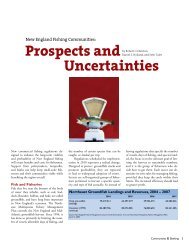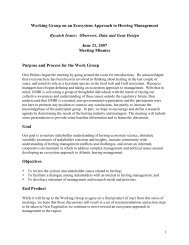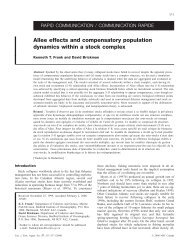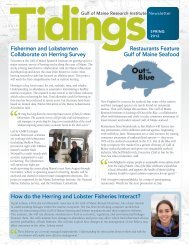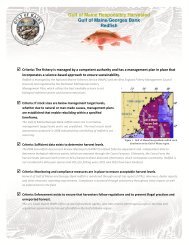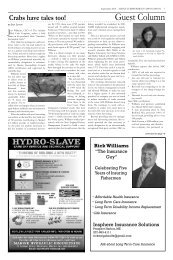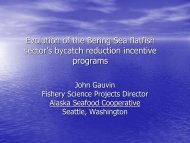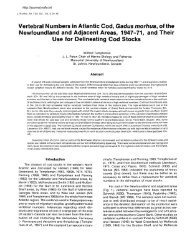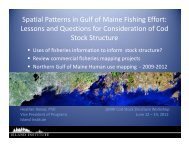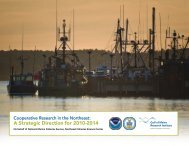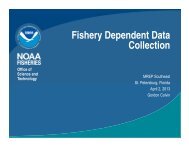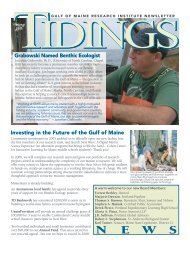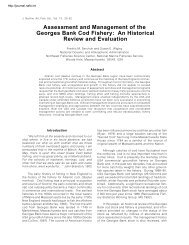Community-based Sectors for the New England Groundfish Fishery
Community-based Sectors for the New England Groundfish Fishery
Community-based Sectors for the New England Groundfish Fishery
Create successful ePaper yourself
Turn your PDF publications into a flip-book with our unique Google optimized e-Paper software.
Table 8: Portland <strong>Sectors</strong> A and B Vessels’ share of landings<br />
<strong>for</strong> two allocation periods FY01-05 and FY96-01<br />
Stock and species<br />
Total FY01-05<br />
Landings<br />
Portland (A)<br />
Sector Share<br />
Portland (B)<br />
Sector Share<br />
Total FY96-01<br />
Landings<br />
Portland (A)<br />
Sector Share<br />
Portland (B)<br />
Sector Share<br />
GB COD 66,166,000 4.6% 3.5% 112,927,645 3.9% 3.3%<br />
GB HADDOCK 66,001,000 8.3% 7.1% 35,687,670 9.0% 7.0%<br />
GB WINTER FLOUNDER 26,960,000 0.6% 0.5% 18,897,799 0.3% 0.2%<br />
GB YELLOWTAIL 39,925,000 0.5% 0.3% 32,548,287 0.4% 0.3%<br />
GOM COD 42,105,000 11.1% 6.9% 56,395,433 12.2% 7.8%<br />
GOM HADDOCK 10,769,000 21.6% 10.5% 10,209,311 33.8% 18.0%<br />
GOM/CC WINTER FLOUNDER 6,072,000 0.3% 0.2% 7,137,377 0.7% 0.5%<br />
GOM/CC YELLOWTAIL 16,218,000 0.3% 0.3% 20,140,336 0.7% 0.5%<br />
GOM/GB WINDOWPANE 274,000 0.0% 0.0% 3,416,338 0.1% 0.1%<br />
PLAICE 27,593,000 30.5% 17.2% 52,992,348 25.9% 14.5%<br />
POLLOCK 52,853,000 26.8% 16.3% 56,561,783 20.2% 12.4%<br />
REDFISH 4,461,000 30.7% 16.3% 4,061,337 28.8% 16.0%<br />
SNE/MA HADDOCK 76,000 4.8% 2.2% 84,641 5.6% 1.7%<br />
SNE/MA WINDOWPANE 633,000 0.0% 0.0% 1,320,000 0.0% 0.0%<br />
SNE/MA WINTER FLOUNDER 25,217,000 0.3% 0.3% 47,371,788 0.1% 0.1%<br />
SNE/MA YELLOWTAIL 4,118,000 0.0% 0.0% 9,954,000 0.0% 0.0%<br />
WHITE HAKE 37,850,000 38.7% 24.3% 38,320,463 27.5% 18.3%<br />
WITCH FLOUNDER 32,599,000 19.9% 11.4% 30,024,873 22.2% 11.1%<br />
NFMA MONKFISH 142,821,000 22.9% 13.3% 147,201,370 18.1% 10.3%<br />
SFMA MONKFISH 102,724,000 1.7% 1.6% 190,073,556 1.9% 1.8%<br />
The sector would not restrict <strong>the</strong> operations of member vessels geographically since some of <strong>the</strong><br />
member vessels have catch histories <strong>for</strong> Georges Bank and Sou<strong>the</strong>rn <strong>New</strong> <strong>England</strong> stocks and are<br />
capable of taking multiday trips to utilize allocations <strong>for</strong> those areas. Because <strong>the</strong> catch of all<br />
managed species would be constrained by hard TACs, <strong>the</strong> sector would request that it be<br />
exempted from o<strong>the</strong>r regulations designed primarily to control fishing mortality. Specifically <strong>the</strong><br />
sector would request to be exempted from: Nor<strong>the</strong>ast Multispecies Days at Sea (DAS) limits,<br />
Monkfish DAS limits 10 , trip limits on cod, yellowtail flounder, winter flounder and white hake,<br />
possession and landing limits on monkfish, <strong>the</strong> May seasonal closure <strong>for</strong> Georges Banks, and<br />
Gulf of Maine rolling closures. The sectors would continue to be subject to <strong>the</strong> same restrictions<br />
on year-round closed areas and gear as o<strong>the</strong>r multispecies vessels. Initially, <strong>the</strong> sector would not<br />
propose any additional restrictions on gear or vessel characteristics beyond current permit<br />
restrictions.<br />
The strawman envisions assigning each permit in <strong>the</strong> sector a specific allocation of <strong>the</strong> overall<br />
allocation of each of <strong>the</strong> species-stocks <strong>for</strong> which <strong>the</strong> Sector receives an allocation. These<br />
individual allocations would be <strong>based</strong> on <strong>the</strong> contribution of <strong>the</strong> catch history of <strong>the</strong> permit (i.e.,<br />
its contribution to determining <strong>the</strong> overall sector allocation). Sector members would be free to<br />
utilize <strong>the</strong>se allocations on <strong>the</strong>ir vessels or transfer <strong>the</strong>m to o<strong>the</strong>r vessels within <strong>the</strong> sector upon<br />
notification and approval by <strong>the</strong> sector manager. These allocations would usable only while<br />
operating as part of <strong>the</strong> sector. Should <strong>the</strong>y leave <strong>the</strong> sector or <strong>the</strong> sector not be renewed, <strong>the</strong>se<br />
vessels would again be subject to <strong>the</strong> same ef<strong>for</strong>t controls as <strong>the</strong> rest of <strong>the</strong> multispecies fleet not<br />
enrolled in a sector. The approach of giving individual allocations was nearly universally<br />
supported by <strong>the</strong> individuals I spoke with. However, <strong>the</strong>se individuals, <strong>for</strong> <strong>the</strong> most part have<br />
relatively large individual catch histories. It is possible that <strong>the</strong> sector might settle on some o<strong>the</strong>r<br />
allocation <strong>for</strong>mula. In any case, <strong>the</strong> economic analysis that follows is not explicitly dependent on<br />
<strong>the</strong> assumption though it implicitly assumes that <strong>the</strong>re is no change in overall fixed costs or<br />
average variable costs as a share of revenues.<br />
10 This would require changes to <strong>the</strong> Monkfish FMP<br />
29


